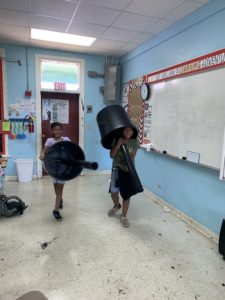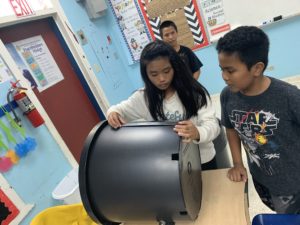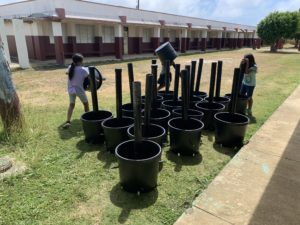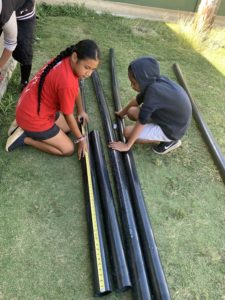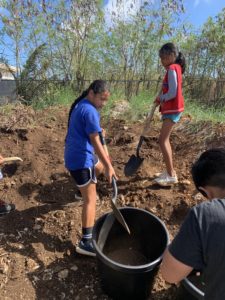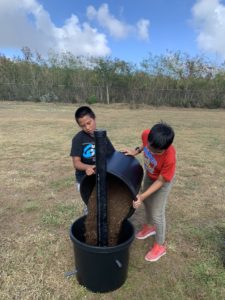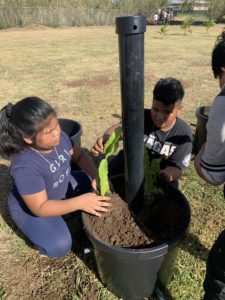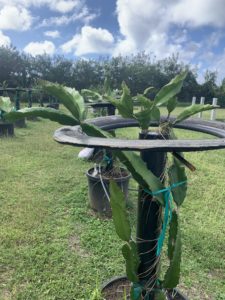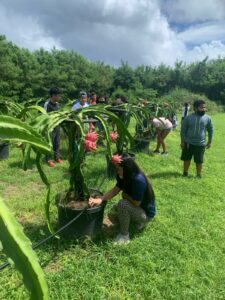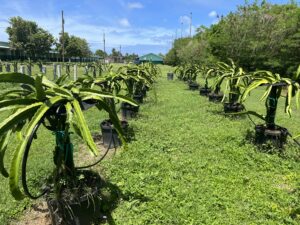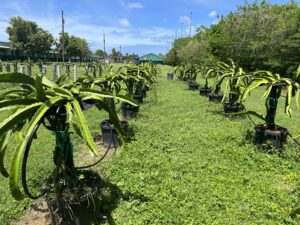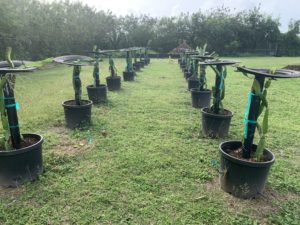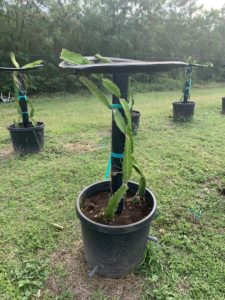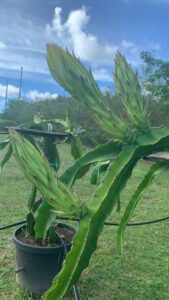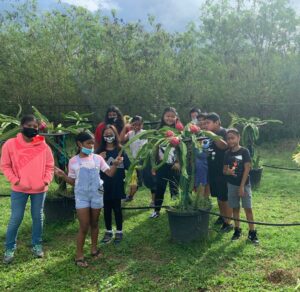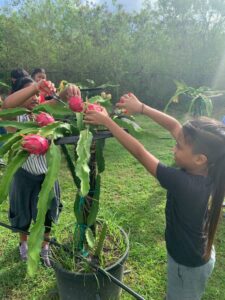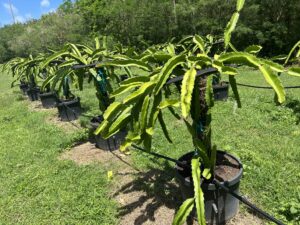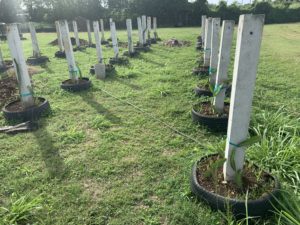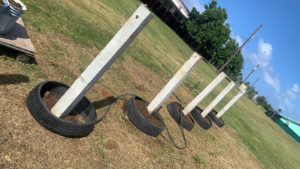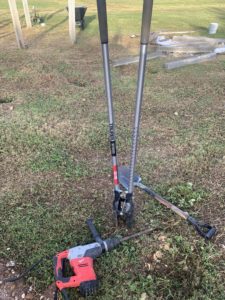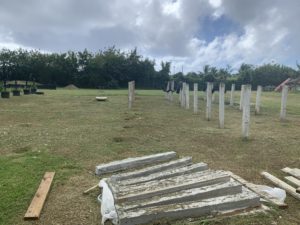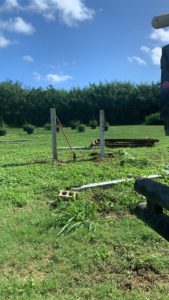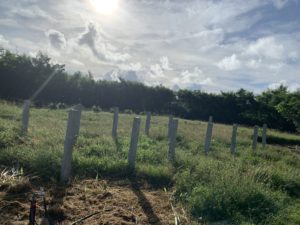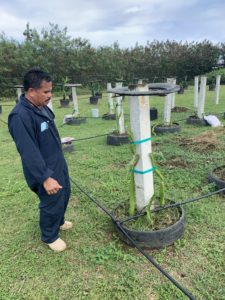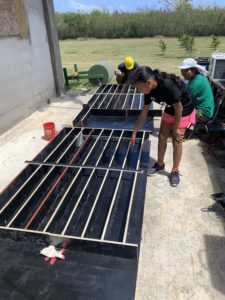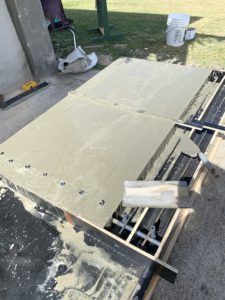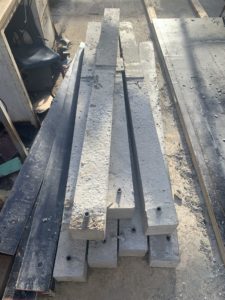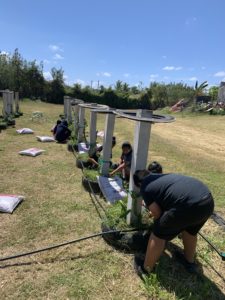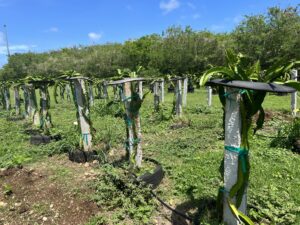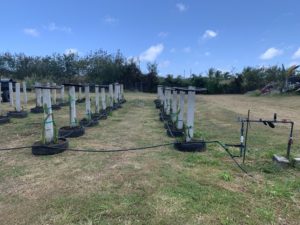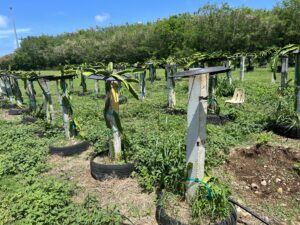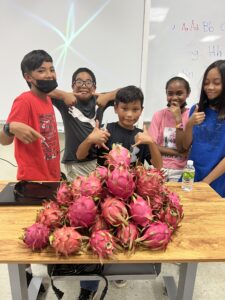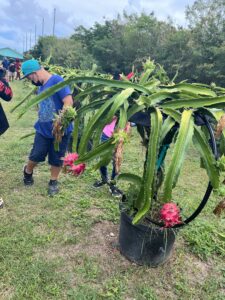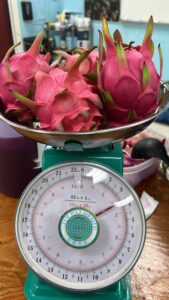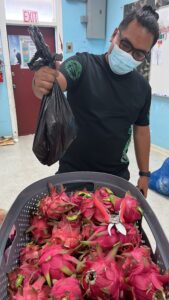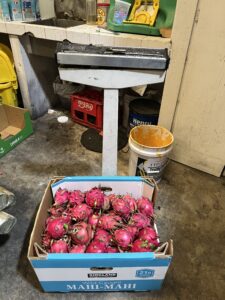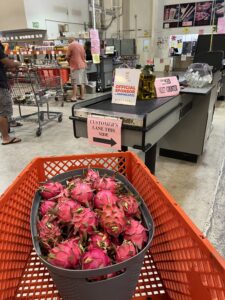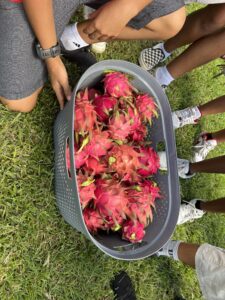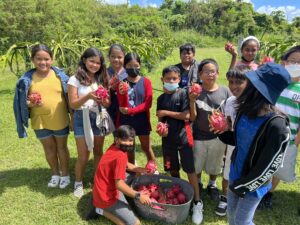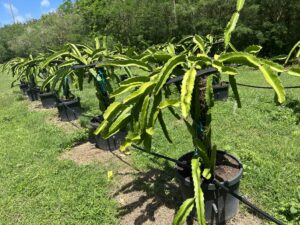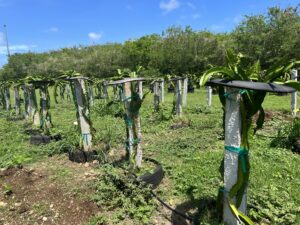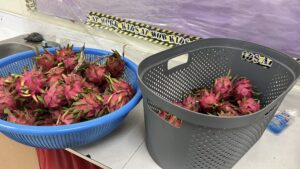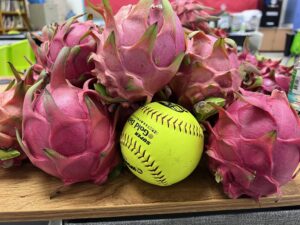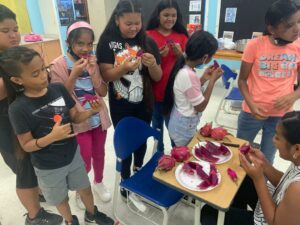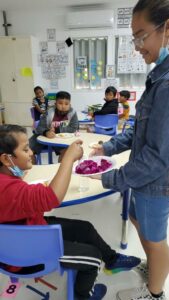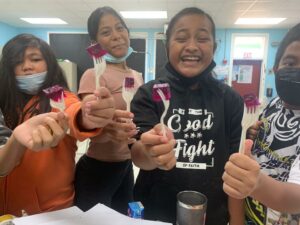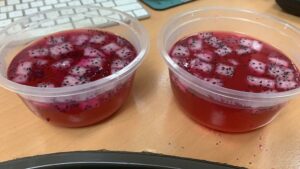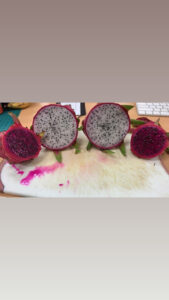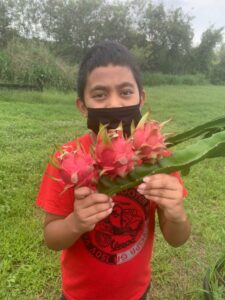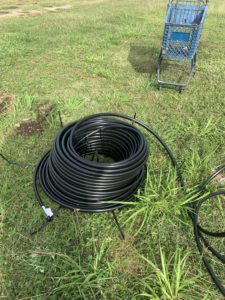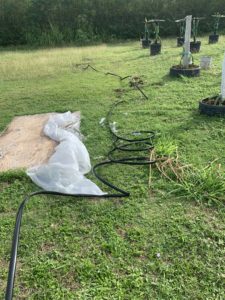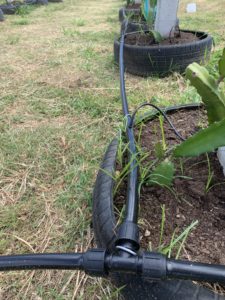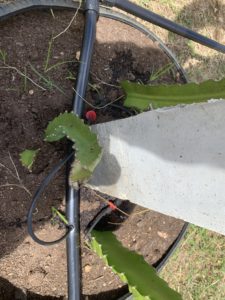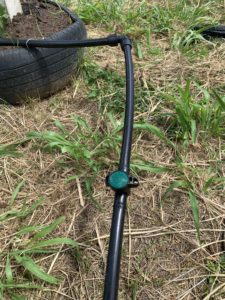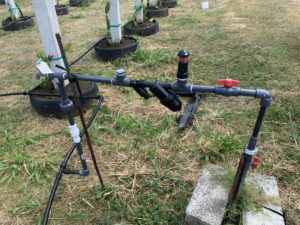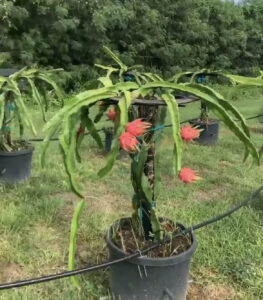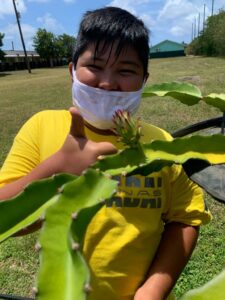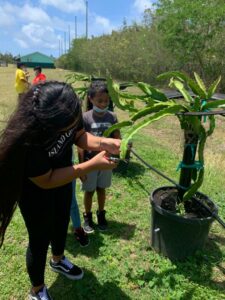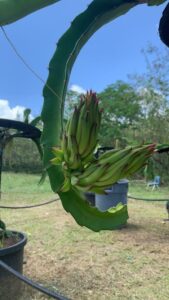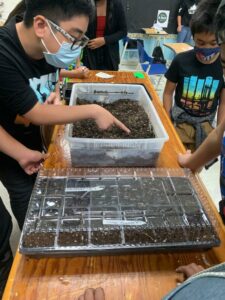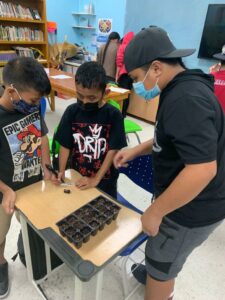Final report for FW19-345
Project Information
Title: Improve dragon fruit production in the Northern Marianas Island through hands-on student education
Saipan has a growing tourist economy that increased by 21% this past year. However, only several thousand acres are currently farmed compared to the almost 40,000 farmed before WWII, so most of the food is imported. The few farmers that are producing dragon fruit say it is easy to sell and they could sell more if they could produce more.
This proposal will enhance the quality of science education at Koblerville Elementary School. Adding dragon fruit production to the Koblerville school farm will Increase student income that can be used for educational activities. Also, students will share information with families and relatives who can also choose to be part-time farmers, or make it a full-time activity.
Benefits and impacts to agriculture: Students will learn science concepts as they grow, observe and experiment with growing dragon fruit. The money produced will benefit the school and students by providing other educational opportunities, and the students will be learning business management in the process. The Koblerville farming activities have been ongoing for more than ten (10) years with Francis Mendiola in charge of the project. He works with other teachers interested in using the farm for their own instruction and activities. Students work on the farm during science class time and after-school and Saturdays. The students can take food home for their families, or sell it. Products sold at the school go to the student leaders (STUCO) account that is used for school related activities such as sports, school beautification, and field trips.
1:The Koblerville Elementary School students will conduct experiments following the scientific method with 60 plots divided into three (3) main experiments of 20 plots each: lighting, planting/growing design, and hydration. Each of the three main experimental designs will include additional experiments such as variety of dragon fruit, trellis design, and different soil and fertilizer combinations. The 60 plots will be identified and marked out by October of 2019, and the cuttings will be growing in the experimental designated plots by December 31st of the project's first year.
2: 200 Koblerville Elementary Students will demonstrate increased understanding of business and marketing skills by selling dragon fruit for $1,000 the second year, and $6500 the third year. Marketing outreach will be demonstrated by the distribution of 650 fliers and 50 posters each year of the project. The project facebook page will have 200 followers and the project web page will have an average of 500 visits per month by the end of the projects 2nd year.
Time-line Timeline includes activities, beginning and ending dates of activities, and which team members are responsible for the activity.
Cooperators
- - Technical Advisor
- (Educator)
- - Producer
Research
Set up three (3) experimental dragon fruit growing plots, with each plot having 20 trellises each. Group #1 will use different trellis designs, Group #2 will use artificial lighting, Group #3 different hydration methods. Within the three main experimental areas, groups will experiment with:
- Different varieties of dragon fruit
- Different dragon fruit growth heights (also included in the trellis designs)
- Experiment on synergistic companion plants
- Different pest control designs
- Designs that can withstand or recover quickly from typhoons
Students will set up their experimental designs using the scientific method and record the results in their science journals and notebooks. Digital photos and spreadsheet documentation, as well as scanned science notebook numbers and drawings, will be stored in the student google drive folders; all of which will be part of the student's science grade.
Results expected: By the end of the project’s twelfth (12th) month,150 community members will participate in the project grand beginning. 60 trellises will have dragon fruit growing on them. Growth rates will be identified and categorised.
Criteria for evaluating: Sign-in sheets from the project grand beginning, and the following years' sign-in sheets for the project related PTA meeting. The students involved in the Dragon Fruit project will have drawings and graphs showing dragon fruit grow rates grouped by the different growing conditions and this will also document the number of trellis growing dragon fruit. The students will upload digital photos to their google drives to verify growth rates and appearances.
200 Koblerville students participating in hands-on science and the after-school farming/science activities will demonstrate business knowledge and skills. By the end of the project’s twenty-fourth (24th) month,200 students, each year, will receive instruction in business management, and will demonstrate their skills by promoting and selling dragon fruit.
Criteria for evaluating: Sales receipts from hotels, farmers’s market, local produce sales vendors, grocery stores, and local sales at Koblerville Elementary School. Promotions by number of facebook followers, and visits to project web page.
By the end of the project’s thirty-sixth (36th) month, locally grown dragon fruit will be growing at the homes of 100 or more Koblerville students. Criteria for evaluating: Documentation uploaded to student google drives.
The project will be determined as success if it achieves the two main objectives of 200 students participating in the project each year using the scientific method with 60 trellises growing dragon fruit, and 200 students, each year, show improved business management skills through business activities recorded in their google drives.
Note: 200 students each year does not mean a total of 600 students for the project as many students will participate during all three years of the project.
Twenty trellis were constructed by the students using 25 gallon-sized pots and 4 inch PVC pipes that stood 4 feet tall. The reason behind using these pots was to ensure portability if readjustments needed to be made for additional plot of land to be used. The height specific PVC pipes were used to support the branches of the dragonfruit from strong winds. The irrigation system is laid out to drip water within the pot to maximize water consumption.
As shown below, 20 additional trellis were made using concrete mix that created a concrete post which measured up to a height of 5 1/2 feet total. The post was secured in the ground with 1 1/2 feet of the post. Each post weighed about 200 pounds. These were constructed with the help of two teachers at the school. The heavy weight and height of the post could withstand strong winds and support the dragonfruit from falling. In addition, we added a tire around the post on the ground to provide extra soil aboveground. The irrigation system is laid out to drip water within the tire to maximize water consumption. Similar to the previously mentioned-potted trellis.
The third type of trellis are currently being designed with my third year students. It will consist of a set of 20 concrete posts that will be connected with metal pipes ten feet apart. Within the 10 feet distance, the dragronfruit will be planted every foot. A bamboo stick will be placed in the ground to act as a guide and support for the branches to grow upward towards the metal pipe. As the branches grow, eventually it will create a canopy.
As of today, the research is partially executed with the third type of trellis which is the connected concrete posts design. Due to the shortened school year and discontinued summer school outdoor program, we were unable to complete this task. However, we were able to continue the research with the 25-gallon container trellis as well as the concrete pole. We were able to harvest about 385 pounds of dragonfruit from June to August 2022. From our harvest, we were able to sell to our staff and parents as well as one basket of 50 lbs. dragonfruit to a supermarket below the market price. Our students had the opportunity to be able to bring some home to share with their families.
As of now no results have taken yet no production have been produced.
From our observation, the 25-gallon potted trellis produced thicker branches at a faster growing rate compared to the dragonfruit from the concrete post planted in the ground. We were able to harvest 290 pounds of fruit from the potted trellis while the concrete post trellis from the ground produced no yield during our second year.
As a result of our latest harvest, we were able to conclude that the 25-gallon trellis produced more dragon fruit as opposed to the concrete posts. However, the concrete posts produced much larger sizes of dragon fruit despite quantities being lower.
Research Outcomes
Education and Outreach
2. Summer School Program Harvest Sharing and Tasting with lower grade students
3. Dragonfruit Recipe Cooking Activity
Participation Summary:
The educational outreach plan includes:
- Grand beginning activity that will be conducted as a PTA meeting for the beginning of the project.
- Years 2 and 3 will use the project as a beginning of the school year PTA activity.
- Posting of posters, banners and handing out of fliers
- Project web page
- Young farmers will wear promotional t-shirts
Francis Mendiola has wide experience in the use of educational technology. He is experienced in web page design and in the making of educational videos. He has also been involved in numerous promotional activities for STUCO and sports programs, that used similar technology as will be used in the promotion, and documentation of dragon fruit production.
With many of the project students living in tents and other temporary shelters, farming activities can be family activities that are enjoyable, and will provide healthy nutrition. As a community activity that will have over 200 students directly involved in the project, it will be a model project that community members will observe and will become interested in starting their own production in their living areas. As the homes are rebuilt, the home lay-outs can be changed to better accommodate farming areas, and with construction materials and equipment on site, it will be easy to add trellises for use in producing dragon fruit.
For this new school year 2021-2022, we presented the dragon fruit project to our parents during the first PTSA meeting of the year. They approved the program to be under the PTSA Business License in order for us to sell the produce at the Farmers Co Op Market. After the meeting, we gave a tour to some parents of the dragonfruit farm area. We also provided them with a few cuttings for seedlings to take home and try to grow. Our plan as of now is to start selling harvested dragonfruit for this year on June 2022 at the Farmers Market and possibly local grocery stores.
Last June-July 2021 Summer School Program, the students were able to harvest dragonfruit for sharing with other students as well as to bring home to share with their families. They learned how to use marketing skills to advertise their produce for sale. Their potential buyers were the teachers at the school. They sold 150 pounds of dragonfruit at $3.50 per pound and made a profit of $525. Those funds were put into the Student Council account. In addition, the students were interested in creating a dessert with the dragonfruit harvested. They did some research online and found an easy recipe to make a dragonfruit gelatin dessert. They made a few desserts and did a taste test to find the perfect amount of ingredients. The recipe will be used for the upcoming fundraiser this year in June 2022.
Education and Outreach Outcomes
As of date, we have designed three types of dragon fruit trellis to test which would yield the most crops and would be most sustainable for our island's environment. One type of trellis is growing dragon fruit in a 20- gallon planting pot with a 4-foot PVC pipe. The second type of trellis is a 4-foot vertical concrete pole dug into the ground with a spacing of 5 feet away. The third trellis is similar but instead of individual vertical poles it would include two vertical poles with two 20-foot poles attached horizontally. Dragonfruit will be planted a foot and a half from each other.
Prior research has been done to determine the three types of trellis to test by the students' teacher through various videos and online articles of dragon fruit farming. Students are taught about using the scientific method and inquiry to see which yields best results for their project.
One of the challenges during this process included needing to change the location for dragon fruit farming due to an emergency construction project the school needed to begin. It took 2-3 months of waiting for approval for a new plot of land to start the project. The second and third trellis is currently in progress and will be completed in the next week. A big reason for such delay in the project was also due to Supertyphoon Yutu in October of 2018 and numerous weather disturbances that caused setbacks. As a result, our school has been on double-session for over a year since then which means students only come to school for 4 hours a day. With limited time, progress has been slow but still moving forward. With the current CO-VID 19 situation, we are also currently experiencing school temporary shutdown and unsure of future circumstances.
The USDA Natural Resources Conservation Service for the Pacific Islands Area assisted our project this year. Their soil conservationist helped us design an efficient irrigation system that helped us to use time efficiently to water the plants while also conserving water consumption. In addition, they delivered a presentation on water and soil conservation and erosion control for the 5th grade students who are a part of the project.
Our next step would be during the flowering season, where we would teach the students about pollination. They will learn that although dragon fruits are self-pollinating plants, they would be even better in terms of taste and growth with the help of humans to cross pollinate. Students will have the opportunity to try and compare self-pollination versus pollination with help of humans of the dragon fruit plants.
Due to the continued Covid 19 pandemic, our educational methods have presented challenges. The challenges were mostly due to the constant changes in modes of instruction where students were not able to consistently follow the planned timeline of activities for the program. There were many restrictions placed on the activities that were permitted on school campus, therefore, half of the plans were not successfully performed. Despite the setbacks from the restrictions, we were still able to successfully harvest 290 pounds of dragonfruit. From this project research we have learned that the contained potted trellis was a much more effective way of growing dragonfruit. The containment of the dragronfruit helped support the plant much better since it did not need to compete for nutrients as it would have been planted in the ground.
One recommendation I would like to suggest would be to start a research project such as this with a group of students that will continue with the program for the next few years. Currently, new groups of students come in to the research and we have to restart the following school year with a new set of students. I think it would be more beneficial for students to gain that experience and knowledge from the beginning until the end. Ideally, we should start in 3rd grade and as they continue on through 5th grade, they would have more opportunities for trial and error and accurate data collection to see patterns of growth for the dragonfruit.
